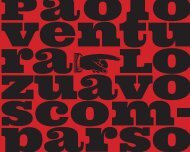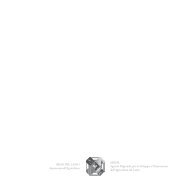Giuseppe Cavalli
Giuseppe Cavalli
Giuseppe Cavalli
- No tags were found...
You also want an ePaper? Increase the reach of your titles
YUMPU automatically turns print PDFs into web optimized ePapers that Google loves.
Titolo da fare<br />
<strong>Giuseppe</strong> <strong>Cavalli</strong><br />
Marco<br />
Delogu<br />
At a time when the debate on the relationship between art and photography is at its liveliest, and there is much<br />
discussion about the borders that separate them, it is important to talk about <strong>Giuseppe</strong> <strong>Cavalli</strong>, since this will help<br />
us to realize that these problematics were dealt with and partially resolved, or rather made redundant, several years<br />
ago.<br />
<strong>Giuseppe</strong> <strong>Cavalli</strong> lived through the great tragedies of Italian twentieth-century history, namely the First and<br />
Second World Wars and Fascism. He emerged with an artistic autonomy by concentrating on and relentlessly pursuing<br />
the subjects most important to him: landscapes, still lifes, portraits. His photographs were often deliberately<br />
timeless, and characterized by a precise, clear-cut language.<br />
He was an artist with distant roots, and one who was mindful of art history (the references to Chardin made by<br />
Angela Madesani in her contribution to this catalogue are most interesting) and modernity, and above all a unique<br />
photographer with his own universe. Last summer I visited a major Cézanne retrospective in Aix-en-Provence and,<br />
at a certain point, I was reminded of <strong>Cavalli</strong> by the unusual balance between microhistory and macrohistory,<br />
between landscapes, portraits and still lifes and between the place where an artist chooses to live and his artistic production.<br />
I think <strong>Cavalli</strong>’s approach to photography was innovative and that he resolved – before the mid twentieth century<br />
– the problem of ‘seizing the moment’. That ‘crucial moment’ that has, in some respects, represented a milestone<br />
in the history of photography, and which in <strong>Cavalli</strong> has a completely different dimension, where the focus is<br />
on waiting and on the constant stimuli generated by vision.<br />
When I was working a lot with Graciela Iturbide, I frequently heard Manuel Alvarez Bravo’s name mentioned<br />
and saw his photos. I was often surprised by the many similarities in the images and subjects of <strong>Cavalli</strong> and Bravo,<br />
two eminent artists who were almost contemporaries. Each with his own personal history, formed in a different country.<br />
Both were photographers who analyzed things in depth, creating individual worlds where they awaited images<br />
that both came from within and appeared before their eyes.<br />
I think that as with all great photographers of the twentieth century, viewing and studying <strong>Giuseppe</strong> <strong>Cavalli</strong>’s<br />
photography reveals the influence of various painters and photographers (Morandi’s and Monachesi’s still lifes, as<br />
well as those of Josef Sudek) and also writers, and particularly to that large group of literary ‘irregulars’ linked neither<br />
to Neorealism nor social commitment. His was a cultivated art through which he constructed a very individual<br />
universe, but which was always reminiscent of other visions, other worlds. Nevertheless, what continues to fascinate<br />
me most about his work is the image of a <strong>Giuseppe</strong> <strong>Cavalli</strong> who lived through half a century without answers and<br />
certainties, only his extremely refined, sober elegance.<br />
174







